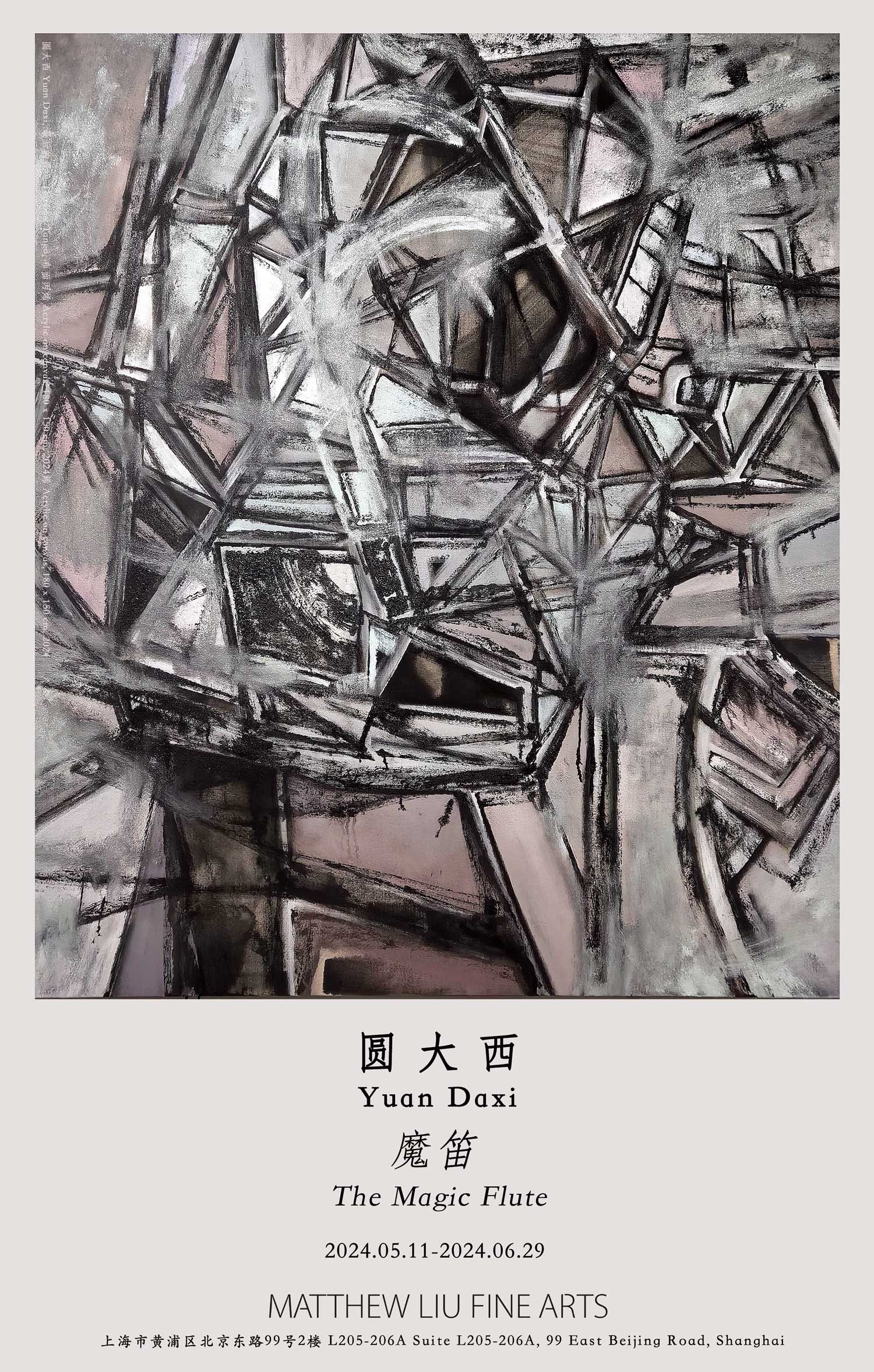展期 Period:
2024.5.11—2024.6.29
艺术家 Artist:
地点 Venue:
新闻稿 Press Release:
德玉堂画廊荣幸地呈现中国当代艺术家圆大西的最新个展《魔笛》。此展以莫扎特生命最后一年完成的歌剧《魔笛》为灵感,探讨艺术家对西方文化,特别是古典音乐的理解与诠释。通过绘画作品,圆大西试图揭示人类心灵在世俗困扰下的挣扎与超越,展现了精神性的永恒力量。
自上世纪80年代起,圆大西便致力于从中国传统艺术向西方当代艺术的转换。他曾学习历史,从事文字创作,擅长书法和山水画。这些经历奠定了他扎实的人文底蕴,也为他后来的艺术探索提供了丰富的养分。圆大西在传统与当代、东方与西方之间游刃有余,形成了独特的艺术语言。作品既有中国水墨画的意境,又吸取了康定斯基、毕加索等现代抽象大师的精髓,体现出一种中西合璧的美学追求。在创作过程中,圆大西融合了丰富的材料和技法。经常在未上胶的亚麻布上作画,使其保留宣纸般的质感。除丙烯颜料外,还大胆尝试矿物质原料如沙石、宝石粉等,营造出粗糙而厚重的肌理。艺术家善于运用强烈的色彩对比,展现戏剧性张力,抒发激越的情感。同时,他的构图又体现出巴洛克音乐般的数学性和逻辑性。直线与曲线、几何形状与不规则图案巧妙结合,呈现出秩序与混沌的对立统一。
从这次展出的作品中,我们可以看到圆大西对古典音乐的迷恋。其中,以莫扎特歌剧贯穿整个展览主线的《魔笛》系列作品,艺术家将歌剧中的象征主义和哲思巧妙融入画面,以此隐喻人性的复杂和灵魂的超脱。尝试用网状的线条表现出一种禁锢感,象征着天才艺术家在现实生活中备受束缚。但画面中跳跃的色彩又昭示着内心的激情和对自由的渴望。正如莫扎特的第四十号交响曲“含着眼泪的微笑”,圆大西笔下的形象似乎在经受苦难,却依然迸发出不屈的力量;而在《生命的赋格》系列中,圆大西进一步探索了巴洛克音乐的结构奥秘。赋格是一种复调音乐形式,以对位法创作而成,逻辑严谨而富于变化。艺术家以抽象的几何图形,勾勒出错综复杂的视觉旋律,展现生命的多重性和无限可能;《春之声》则以明快的色调和流畅的线条,描绘大自然的勃勃生机。振奋人心的旋律仿佛在画布上跃动,召唤生命回归希望与光明;另一组作品《圣咏》和《欧菲莉亚之歌》则与宗教和戏剧息息相关。《圣咏》采用厚重的色块和刚劲有力的笔触,营造出庄严肃穆的氛围。以抽象的形式表达灵性的崇高,引人思索生命的意义;《欧菲莉亚之歌》中飘逸的线条和朦胧的色彩,仿佛在吟唱那个莎翁笔下早逝的少女。生命的脆弱与美丽,在圆大西的画中得到了动人的呈现。此外,《玫瑰骑士》《意大利协奏曲》和《最后的探戈》等作品,则以大胆而富创意的形式,再现了这些经典音乐作品的精髓。
展览题为《魔笛》,指向心灵的救赎之路。莫扎特歌剧中最著名的段落夜后咏叹调,以女高音空灵而激昂的音色,道出人类渴求光明与自由的强烈愿望。圆大西的画作亦是如此,在纷繁芜杂的尘世中,艺术犹如一支魔笛,吹奏出透彻心扉的旋律,引领人们走向精神的皈依。正如《奥本海默》电影中所揭示的,科学的力量虽然伟大,但面对人生的困惑和道德的拷问,即便是杰出的科学家也无法幸免。在追求真理的路途中,我们不得不直面内心的挣扎与困顿。圆大西以其独特的视角和媒介,为我们描绘了一幅现代人的心灵图景,亦为因才华而受困的心灵献上了深情的慰借。在他的笔触下,古典与当代、东方与西方熔于一炉,凝结成恢宏而微妙的诗曲。无声胜有声,此时此刻,让我们从圆大西画作中聆听灵魂的回响,感受生命的拷问与升华。
Matthew Liu Fine Arts is honored to present the latest solo exhibition The Magic Flute by the Chinese contemporary artist Yuan Daxi. Inspired by Mozart's opera The Magic Flute, which he completed in the last year of his life, this exhibition explores the artist's understanding and interpretation of Western culture, particularly classical music. Through his paintings, Yuan attempts to reveal the struggle and transcendence of the human soul under worldly troubles, showcasing the eternal power of spirituality.
Since the 1980s, Yuan has been dedicated to the transition from traditional Chinese art to Western contemporary art. He studied history, engaged in writing, and excelled in calligraphy and landscape painting. These experiences laid a solid cultural foundation for him and provided rich nourishment for his later artistic exploration. Yuan navigates effortlessly between tradition and contemporary, East and West, forming a unique artistic language. His works possess the artistic conception of Chinese ink paintings while absorbing the essence of modern abstract masters such as Kandinsky and Picasso, reflecting a pursuit of the fusion of Chinese and Western aesthetics. In the creative process, Yuan integrates a rich range of materials and techniques. He often paints on unsized linen canvas, allowing it to retain the texture of rice paper. In addition to acrylic paints, he boldly experiments with mineral raw materials such as sand, stone, and gemstone powders, creating a rough and thick texture. The artist skillfully employs strong color contrasts to create dramatic tension and express intense emotions. At the same time, his compositions reflect the mathematical and logical nature of Baroque music. Straight lines and curves, geometric shapes, and irregular patterns are cleverly combined, presenting a unity of opposites between order and chaos.
From the works exhibited in this exhibition, we can see Yuan's fascination with classical music. Among them, in the The Magic Flute series, which runs through the entire exhibition, the artist ingeniously incorporates the symbolism and philosophy of the opera into the paintings, metaphorically exploring the complexity of human nature and the transcendence of the soul. He attempts to express a sense of confinement with net-like lines, symbolizing the brilliant artist being fettered in real life. However, the leaping colors in the paintings also indicate the inner passion and desire for freedom. Just like Mozart's Symphony No. 40 "smiling through tears," the figures under Yuan's brush seem to be suffering, yet still bursting with unyielding strength. In the Fugue of Life series, Yuan further explores the structural mysteries of Baroque music. Fugue is a form of polyphonic music composed using counterpoint, rigorous in logic and rich in variation. The artist outlines intricate visual melodies with abstract geometric shapes, showcasing the multiplicity and infinite possibilities of life. The Voice of Spring, on the other hand, depicts the vibrant vitality of nature with bright colors and fluid lines. The uplifting melody seems to dance on the canvas, calling for life to return to hope and light. Another group of works, Chant and Ophelia's Song, are closely related to religion and drama. Chant employs heavy color blocks and vigorous brushstrokes to create a solemn atmosphere, expressing the sublimity of spirituality in an abstract form, prompting people to ponder the meaning of life. The flowing lines and hazy colors in Ophelia's Song seem to sing of the early-deceased maiden from Shakespeare's pen. The fragility and beauty of life are touchingly presented in Yuan's paintings. In addition, works such as The Knight of the Rose, Italian Concerto and The Last Tango reproduce the essence of these classic musical pieces in bold and creative forms.
The exhibition, titled The Magic Flute, points to the path of spiritual redemption. The most famous passage in Mozart's opera, the Queen of the Night aria, expresses the strong desire for light and freedom with the ethereal and passionate timbre of the soprano. Yuan's paintings are likewise. In the complex and chaotic world, art, like a magic flute, plays a melody that penetrates the heart and leads people toward spiritual refuge. As revealed in the movie Oppenheimer, although the power of science is great, even outstanding scientists cannot escape the perplexities of life and the questioning of morality. On the path of pursuing truth, we have to face the struggles and difficulties within. Yuan, with his unique perspective and medium, depicts a landscape of the modern human soul and offers a deep consolation to those souls trapped by their talents. Under his brush, the classical and the contemporary, the East and the West, melt into a grand and subtle poetic song. Silence surpasses sound. At this moment, let us hear the echoes of the soul from Yuan's paintings and feel the interrogation and sublimation of life.

